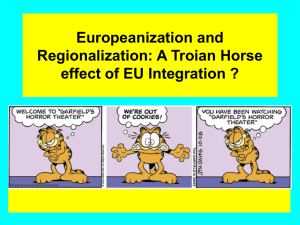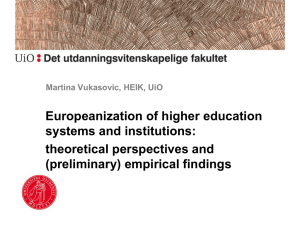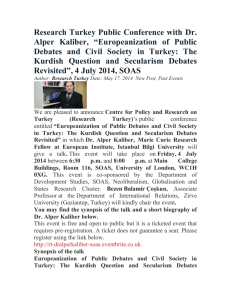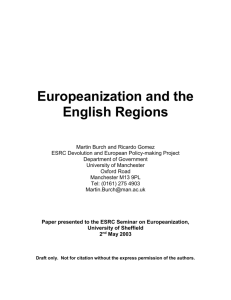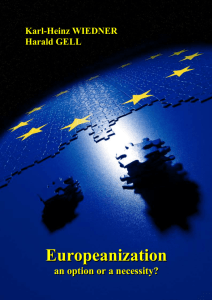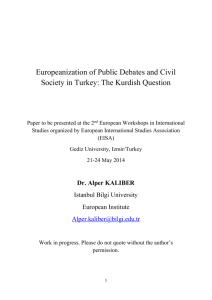- Archive of European Integration
advertisement
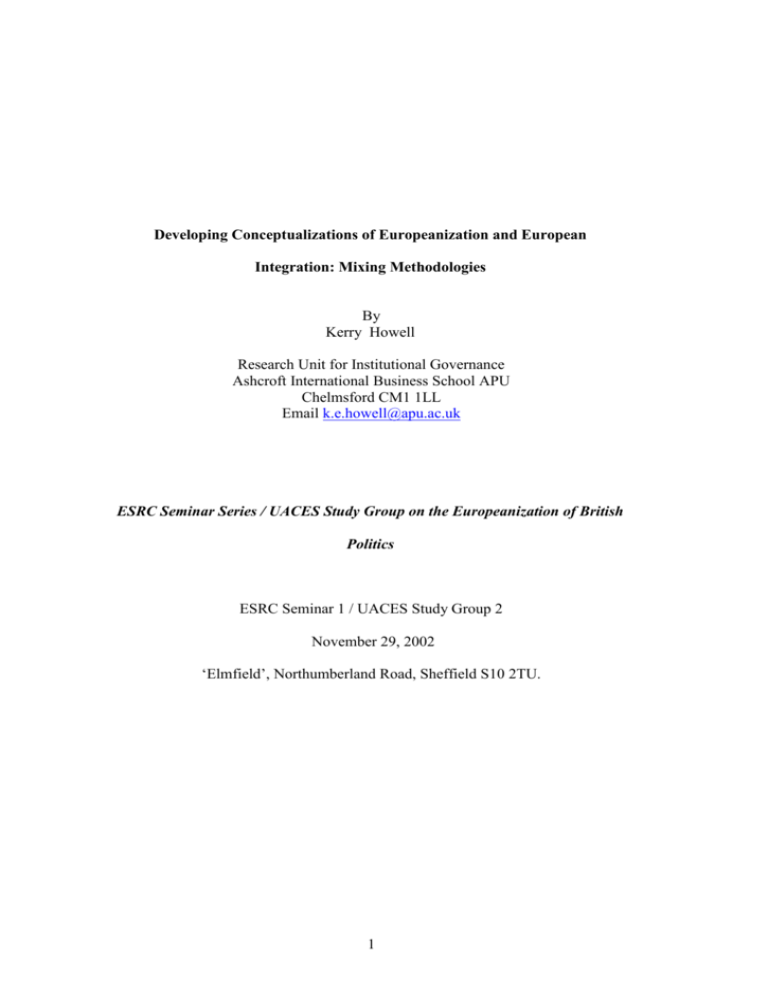
Developing Conceptualizations of Europeanization and European Integration: Mixing Methodologies By Kerry Howell Research Unit for Institutional Governance Ashcroft International Business School APU Chelmsford CM1 1LL Email k.e.howell@apu.ac.uk ESRC Seminar Series / UACES Study Group on the Europeanization of British Politics ESRC Seminar 1 / UACES Study Group 2 November 29, 2002 ‘Elmfield’, Northumberland Road, Sheffield S10 2TU. 1 Abstract In its most explicit form Europeanization is conceptualized as the process of downloading European Union (EU) directives, regulations and institutional structures to the domestic level. However, this conceptualization of Europeanization has been extended in the literature in terms of up-loading to the EU, shared beliefs, informal and formal rules, discourse, identities and vertical and horizontal policy transfer. Further issues regarding conceptualizations of Europeanization relate to direct and indirect impacts, diversity and uniformity and fit and misfit. There are also problems concerning the differences and similarities between Europeanization and European integration and whether the former offers anything new to the study and analysis of the EU. To deal with some of these issues this paper re-assesses neo-functionalism as a grand theory from a nonpositivist perspective. It then uses Europeanization as a meta-theory to break down aspects of neo-functionalism, which allows elements of positivism to be reintroduced to the analysis and along with constructivism provide greater explanatory power regarding European integration. Overall, this paper examines the difference between Europeanization and European integration and outlines a working conceptualization of Europeanization. 2 Developing Conceptualizations of Europeanization and European Integration: Mixing Methodologies Introduction This paper is concerned with developing a conceptualization of Europeanization and providing an understanding of its ongoing dialectical relationship with European integration. To achieve this the paper necessitates the pursuit of two interrelated objectives. First, a re-assessment of neo-functionalism as a grand European integration theory from a non-positivist perspective and through this reassessment, bring together elements of positivism and constructivism1 in a conceptualization of Europeanization. Second, examine the differences and similarities between European integration theory and Europeanization and through a break down of neo-functionalism identify separate aspects of Europeanization. This will allow empirical reliability of elements of neofunctionalism through a working conceptualization of Europeanization. In this study reality and theory are understood to develop through interactions between historical environments, institutions and individuals. In this way the paper makes three discrete points. First, social actors in a continually changing 1 This paper recognizes that positivism and constructivism may be broken down into more specific methodologies but uses these terms in a general way to identify the differences between scientific approaches in the context of testing theory through deductive methods, empirical reliability and dependent and independent variables and constructing theory through empirical validity and inductive and interpretative methods. Furthermore, the paper recognizes the difference between positivist and post-positivist approaches but again uses positivism in a general context (for further see Lincoln and Guba, 2001). 3 historical context construct reality and theory. Second, social scientists continually develop the concepts they employ, as the limitations of these concepts become explicit. Third, social scientists cannot be objective impassive analysts; they themselves are part of the construction process, as communal values change theory is re-assessed in relation to these changes (George, 1976). As noted by Ashead (2002), Bulmer and Burch, (2001), Dyson (2000) and George (1976) as grand theories of European integration came under scrutiny and their problems became explicit, social scientists developed meta-theories to deal with their limitations. Europeanization can be perceived as a meta-theory particularly in relation to neo-functionalism and intergovernmentalism. Because of the criticisms levelled at neo-functionalism this paper re-assesses this grand theory in the context of historical change and social scientists value based re-formulations of European integration theory. The paper argues that a predictive theory in the social sciences is difficult if not impossible to formulate, consequently it argues for grand theory such as neo-functionalism, to be seen as a means of ‘organising concepts’, ‘selecting relevant facts’ and determining how the ‘narrative should be constructed’ (George, 1976). That neo-functionalism in particular or integration theory/international relations in general should not provide the former understanding of theory but concentrate on the latter. Indeed, grand theories should concentrate on the latter and meta-theories such as Europeanization should attempt to enable verifiable generalizations and empirical reliability but not at the cost of thicker understandings of process in terms of interaction and continuity. 4 Initially, this paper summarises conceptualizations of Europeanization that have been forwarded over the last decade. Second, it discusses some issues relating to these conceptualizations and provides some independent analysis. Third, it overviews the difficulties relating to the conceptualization of Europeanization in relation to European integration. Indeed, it illustrates how re-assessing neofunctionalism through changed value structures may enhance our utilization of Europeanization and consequent analysis of the EU and European integration theory. Overviewing Europeanization Olsen (2002) argued that Europeanization was a fashionable term for which there were many definitions. In fact, he inquired, that given the uncertainty that surrounded the concept was it worth bothering with? A number of academics argued that Europeanization was a useful concept. That Europeanization may be a fashionable term but it was worth bothering with, even though it needed further exploration, explanation and conceptualization. For further, see Bomberg and Peterson, (2000), Börzel, (1999; 2002), Börzel and Risse (2000), Buller and Gamble (2002), Bulmer and Burch (2001), Dyson (2000; 2002), Dyson and Goetz (2002), Featherstone and Kazamias (2001), George, (2001), Goetz and Hix (2000), Ladrech (1994), Olsen (2002), Radaelli (2000), Risse et al (2001). Dyson and Goetz (2002) pointed out the difficulties relating to Europeanization when they indicated how the term was used in a number of different ways, “ … it is sometimes used narrowly to refer to implementation of EU legislation or more broadly to capture policy transfer and learning within the EU. It is sometimes 5 used to identify the shift of national policy paradigms and instruments to the EU level. (Other) … times it is used in a narrower way to refer to its effects at the domestic level … or in a more expansive way to include affects on discourse and identities as well as structures and policies at the domestic level” (p 2 author’s brackets). Ladrech (1994) provided a starting point when he argued that Europeanization occurs when EU political dynamics become part of the logic and norms of domestic policy-making. He defined Europeanization as “ … an incremental process reorienting the direction and shape of politics to the degree that EC political and economic dynamics become part of the organizational logic of national logic of national politics and policy-making” (p 70). This seems to necessitate a process of downloading or top-down procedures, which following some discussion was ultimately forwarded by Börzel and Risse (2000), Buller and Gamble (2002), Hix and Goetz (2000) and George (2001). George (2001) acknowledged that the interpretation of “ … Europeanization explored in (his) paper is only part of a larger … two way process” (p 1 author’s brackets). However, his focus was the impact of the EU on the UK system. Buller and Gamble (2002) also explored wider conceptualizations of Europeanization but ultimately considered it to be “ … a situation where distinct modes of European governance have transformed aspects of domestic politics” (p 17). Fundamentally, they wished to explore whether Europeanization existed at member state level but recognized that outcomes are not inevitable and rely on interactions between member states and the domestic and EU levels (ibid). Overall though, the main emphasis 6 for these conceptualizations of Europeanization was a concentration on the downloading or top-down perspective or EU effects on domestic policies etc. In a similar way, Hix and Goetz (2000) identified European integration as an independent variable and change in domestic systems or Europeanization as the dependent variable. This is a useful distinction if Europeanization is the outcome of change at the domestic level however, if the domestic level initiates change at in the EU and affects European integration then the variables are reversed. The relationship between European integration and Europeanization is interactive and the distinction between the dependent and independent variable obscured. Europeanization as an interactive process in that it involves bottom-up and top-down procedures or projection and reception. “To dissect Europeanisation as reception and projection highlights our view of the relationship between the EU and member-government institutions as iterative and interactive. It is difficult to try to conceive of the relationship in conventional, positivist social science terms i.e. with independent and dependent variables and simple causality if analysis is to capture incrementalism and continuity (Bulmer and Burch, 2001; p 78). Dyson (2002) explained that “ … Europeanization remains a relatively new theoretical interest and has produced more questions than answers” (p 3). In the same fashion Featherstone and Kazamias (2001) proposed that Europeanization was a “ … dynamic process unfolding over time” and through complex interactive variables it provided contradictory, divergent and contingent effects. However, they ultimately argued that Europeanization included both the domestic and EU levels of policy-making and stressed the interdependence between the two. Indeed, they ‘focus’ on the expansion of EU institutions and their policy-making 7 capabilities as well as changes in member states based on such expansions (ibid). In other words, concentration on downloading alone was not sufficient and uploading needed to be considered in an understanding of the EU as process. Risse et al (2001) identified both downloading and up-loading when they perceived Europeanization as the “ … emergence and development at the European level of distinct structures of governance, that is, of political legal and social institutions associated with political problem solving that formalizes interactions among the actors, and of policy networks specializing in the creation of authoritative European rules” (p 3). This initially seems to encompass a definition similar to European integration. However, it is the emphasis on ‘emergence and development’ that identifies the Europeanization process as one of up-loading in the development of EU institutions and downloading in terms of ‘authoritative European rules’. Indeed, the emphasis on the creation of rules at the EU level moves away from a utilization of Europeanization as purely downloading to one that entails “ … the evolution of European institutions that impact on political processes and structures of the member states” (Börzel, 2002; p 193). Where Europeanization incorporates an interactive process in that it involves bottom-up and top-down procedures. A further interpretation of Europeanization can be found in the context of policy transfer. Bomberg and Peterson (2000) for example, examined the links between policy transfer and Europeanization and raised questions regarding Europeanization by stealth. They considered that both areas have become common concepts in the EU policy-making literature, however links between 8 them have remained unexplored. They accepted that the EU has a political process embedded in procedures and treaties but investigated the extent that the established process at the EU level still provides the main impetus behind policymaking in Europe. Finally, there are interpretations of Europeanization that take more general concepts which consider it to include, “ … processes of (a) construction (b) diffusion (c) institutionalization of formal and informal rules, procedures, policy paradigms, styles, ‘ways of doing things’ and shared beliefs and norms which are first defined and consolidated in the making of EU decisions and then incorporated in the logic of domestic discourse, identities, political structures and public policies” (Radealli, 2000; p 4). However, these broad definitions lead to an inclusive conceptualization of Europeanization and brokers criticisms of ‘conceptual stretching’. In this context, Radaelli (2000) argued that Europeanization was difficult to define because, if all things have been touched by Europe, to some extent or other, all things have been Europeanized. If Europeanization can be used to explain “ … cultural change, new identity formation, policy change, administrative innovation and even modernisation” (ibid). It eventually becomes all things to all people and to some extent almost meaningless. For Radaelli (2001) the most appropriate course of action would be to unpack the concept and distinguish between related concepts like convergence, harmonization and political integration. Olsen (2002) argued that it was not important to know what Europeanization was “ … but whether and how the term can be useful for understanding the dynamics of the evolving European polity” (ibid, p 1). In the next section this paper unpacks Europeanization in relation to 9 separate definitions and interpretations of the concept in an attempt to render it useful in comprehending the evolving EU. Developing and Analysing Europeanization Europeanization has numerous definitions, which some commentators argue detracts from its explanatory power and leaves us with a case of ‘conceptual stretching’ (Radaelli, 2000). To deal with ‘conceptual stretching’ and levels of inclusion and exclusion this section of the paper breaks down the theory into constituent parts and proposes two categories of Europeanization with specific ‘content’ in relation to European integration. Each distinguishes between the extent Europeanization can be empirically validated and said to have been a variable in the process of EU and member state transformation. Finally the section identifies the differences and similarities between Europeanization and European integration. Europeanization 1 (En1) entails downloading or top-down Europeanization and is based on conceptualizations forwarded by Buller and Gamble (2002), Dyson and Goetz (2002), George (2002) and Ladrech (1994). (These commentators provide analysis of wider perspectives of Europeanization but emphasise En1 because of its clarity in terms of explanatory power and empirical clarity). Europeanization 2 (En2) incorporates up-loading or bottom-up Europeanization and is based on conceptualizations indicated by Börzel (2002), Bulmer and Burch (2001), Dyson (2000), Featherstone and Kazamias (2001) and Risse et al (2001). (In most instances, these conceptualizations identify interactions between En1 and En2). 10 ‘Content’ of Europeanization incorporates policy transfer as identified by Bomberg and Peterson (2000) and shared beliefs, identified by Radealli (2001) and Olsen (2002). Shared beliefs may be observed in the creation of the Single European Market (SEM) where diverse beliefs relating to the market is streamlined under one regulatory structure. However, even though differing interpretations of regulation re-emerge at the domestic level certain beliefs have been shared e.g. liberal market structures in the SEM (Howell, 1999; 2000). Indeed, the content of Europeanization includes numerous ideas such as institutional norms (accountability), informal rules (democracy), discourse (language used when discussing issues relating to the EU e.g. EMU) and identities (e.g. does the euro provide an EU identity?). If En1 and En2 are examined individually they are easier to subject to empirical analysis than when they are mixed or incorporate difficult elements of content. For example, when investigating identities and how these may have been affected by Europeanization a number of different variables can be observed in terms of localization, regionalization and globalization that make the effects of En1 or En2 difficult to determine. The same may be said of shared beliefs however, even though variables here are difficult to disentangle, one is able to identify shared beliefs in the compromised regulatory structures of the SEM. However, the clearest examples of Europeanization may be found through analysis of structures and policies and the part the EU plays in ‘diffusion and construction’ (Radealli, 2000) or downloading and up-loading. 11 There are also nuances regarding content in terms of different variables, for instance an interpretation of Europeanization relating to policy transfer would need to identify when policy transfer was horizontal and when it was vertical. Vertical policy transfer comes through EU policy or European integration processes. Horizontal policy transfer incorporates learning from and taking on other member state policies without EU involvement. This provides a parameter for Europeanization and deals with ‘conceptual stretching’ in that if an occurrence of policy transfer is to be perceived as Europeanization it needs to come through EU institutions even if this only incorporates co-ordination. However, the level of co-ordination or activity when distinguishing between horizontal and vertical policy transfer is debatable. Featherstone and Kazamias (2001) considered that domestic structures were not the passive recipients of EU impacts. “Domestic and EU institutional settings are intermeshed, with actors engaged in both vertical and horizontal networks and institutional linkages” (p 1). They emphasized changes brought about on domestic policy in terms of fit or misfit and how the member states deal with these. However, “ … Europeanization is assumed to be a two way process, between the domestic and the EU levels, involving both top-down and bottom-up pressures” (ibid, p 6). Indeed, the amount of success in the negotiations at the EU level between domestic actors will determine the level of fit or misfit when it comes to policy implementation. The level of success regarding up-loading (En2) will determine the level of change in relation to downloading (En1). It could be argued that if there has been no misfit at the domestic level change has failed to occur, Europeanization has not taken place. This is when it is important to investigate 12 bottom-up processes of Europeanization and identify the levels of success in member state up-loading. If member states have lobbied effectively and had much of their perspective included in policy, misfit will be limited and consequent domestic change will be minimal. This does not mean that Europeanization has not taken place but that bottom-up Europeanization was effective and top-down Europeanization minimized. Europeanization is conceptualized in the context of ‘situation’ in terms of downloading (En1) or up-loading (En2). Each of these conceptualizations allows situations where empirical reliability can be made explicit from a particular perspective. Indeed each individually relies on a positivist methodology where phenomena can be broken down into independent and dependent variables and provide an analysis and explanation of thin causal effects. However, if a primarily positivist perspective is undertaken “ … we lose sight of the complex, interwoven interdependent relationship between strategy and discursive construction of the constraints and opportunities” involved in the process of European integration (Dyson, 2000; p 647). If the study is to ensure an all round understanding of the affects of Europeanization on the EU and member states an analysis needs to include both En1 and En2 and instances of content. To provide empirical reliability and validity and the ‘interwoven relationships’ at work in the EU, Europeanization needs to identify aspects of fit and misfit and see the interaction between En1 and En2 as an example of ‘process’. In such a way elements of constructivism are brought into the analysis where the variables are changeable and findings created as investigation proceeds. Through bringing together different aspects of Europeanization we are not simply pursuing theory testing but 13 ‘organizing concepts’, ‘selecting relevant facts’ and constructing narrative as well as ensuring levels of empirical reliability (George, 1976). This moves the study away from ‘thin causal effects’ toward thicker understandings and perspectives of processes at work in the EU (Dyson, 2000). Olsen (2002) identified Europeanization as the changes taking place in member states then outlines processes of institutional change that may identify how/why it takes place. However, even though he indicates separate interpretations of Europeanization the different conceptualizations are inclusive rather than exclusive. In his paper Olsen separates Europeanization into five possible phenomena when examining what is actually changing and considers that it may be seen as: (a) Changes in external territorial boundaries (b) Governance institutions developed at the supranational level (c) Influencing and imposing supranationality at the sub-national and national levels (d) Exporting governance procedure and policy specific for EU beyond EU borders (e) A project of a political nature aimed at intensifying the unification of the EU. There are a number of issues regarding these proposed elements of Europeanization. Changes to external borders or enlargement incorporates a change in the domestic policies of those joining the EU and existing members who will change policy to take this extension into account. In this context, 14 accession states under-go vertical policy transfer prior to EU membership and EU governance procedures are exported beyond EU borders. Developed governance institutions at the supranational level indicate European integration; however the development of the EU policy-making institutions incorporates up-loading and bottom-up Europeanization (En2). This creates a slight problem because the development of EU policy-making institutions is continual so to deal with the interaction between Europeanization and European integration in this way one needs to take a snapshot from a bottom-up perspective. The same may be said of the changes to the domestic level through the imposition of supranationality on sub-national and national levels. This may be identified as the top-down effects of Europeanization (En1) on both member and non-member states, again the paper recognises the interaction between European integration and Europeanization and the need to provide a snapshot from a top-down and/or bottom-up perspectives. However, to provide a full understanding of the EU each snapshot will need to take into consideration aspects of the other and the interactions between En1 and En2. To provide an indication of the different aspects of Europeanization in relation to European integration this paper deconstructs neo-functionalism, which as a grand theory attempted to deal with the issues under discussion in terms of supranationality and spillover. Europeanization and European Integration: Reassessing Neo-Functionalism In addition to difficulties with Europeanization we also encounter conceptual problems regarding European integration. For instance, in some definitions it is difficult to distinguish between Europeanization and European integration and in 15 others they seem to be identical. In this context, why bother with the notion of Europeanization? Why not simply carry on with the well-worn but tried and tested idea of European integration? As noted above Olsen (2002) concluded that the EU was a political project (in the context of unification) and it is in this way that European integration and Europeanization could be seen as one and the same thing. To assess the relationship between Europeanization and European integration, existing grand theory needs to be investigated. Indeed, it is through this investigation that deficiencies with Europeanization and European integration theory may be overcome. Through a re-assessment of a primary grand theory from a nonpositivist perspective we may better comprehend the differences and similarities between European integration and Europeanization and how both may extend our comprehension of European integration. Consequently, by breaking down Europeanization into En1, En2 etc we may make better use of the meta-theory in relation to neo-functionalism or the grand theory. This may provide the basis for verification and generalization regarding certain aspects of neo-functionalism but also allow for areas, which are more difficult to empirically verify to also undergo investigation. In such a way aspects of positivism and constructivism may be brought together in the analysis of European integration. Haas (1958) provided an explanation of the process and progression of European integration through his analysis of supranationality, sub-national interests and spillover. He argued that sub-national actors “ … in several distinct national settings are persuaded to shift their loyalties, expectations and political activities 16 toward a new centre, whose institutions possess or demand jurisdiction over the pre-existing national states” (p 16). This was similar to Lindberg (1963) who considered that European integration was “(a) The process whereby nations forgo the desire and ability to conduct foreign and key domestic policies independently of each other, seeking instead to make joint decisions or to delegate the decisionmaking process to new central organs; and (b) the process whereby political actors in several distinct settings are persuaded to shift their expectations and political activities to a new centre” (p 6). In both of these theorists we can identify the shift toward a new political centre or supranational institution and the shift of loyalties by sub-national actors toward this institution. Fundamentally, subnational interests shift their allegiance to a supranational body and in doing so further develop supranational institutions and provide a stimulus for spillover. Spillover can be broken down into three types: functional spillover, which is indicated when integration in one industry/sector creates its own impetus and necessitates further integration both in the same, and in other industries/sectors. Second, cultivated spillover, which assumes that the European Commission will be pro-active in the management of European integration. Third, institutional/political spillover which “ … describes the accretion of new powers and tasks to a central institutional structure, based on changing demands and the expectation on the part of such political actors as interest groups, political parties and bureaucracies” (Haas, cited in Kirchner, 1976; p 3). Effectively, there is an interplay between spillover and supranationality in that the “ … establishment of supranational institutions designed to deal with functionally specific tasks will set in motion economic, social and political processes which generate pressures 17 towards further integration” (Tranholm-Mikkelsen, 1991; p 4). Again this has implications for the development of supranational institutions. Haas (1958) labelled functional spillover the “ … expansive logic of sector integration” (p 243). However, the extent to which changing incentives created by spillover allowed an explanation for task expansion has been a point of contention for neo-functionalists. Nye (1971) argued that the functional linkage of tasks has been a less powerful mechanism than was originally believed to be the case. Whereas, Lindberg and Scheingold (1970) denied that spillover led to the Common Market. Fundamentally, one could argue problems with spillover and European integration theory in general arose as the explanatory power of neo-functionalism was criticized. The main “ … weakness of neo-functionalism was not empirical but theoretical … once the simple teleology toward integration was abandoned neofunctionalism and other grand theories lacked the resources to construct a positive response. Neofunctionalists … concluded that an explanation of integration must be embedded in a multicausal framework comprised of narrower theories” (Moravcsik, 1998; p 14). However, as George (1976) indicated the “ … important question is why?” He suggests that the reason had less to do with what was happening in the EU and more to do with a change in values and interpretations of reality and theory in the USA and “ … that the doubts expressed about neofunctionalism were a reflection of the doubts expressed about the technomanagerial society” (p 33) and difficulties relating to positivist prediction. Indeed, at the same time as neo-functionalism was under scrutiny unified theories in the 18 USA were also undergoing critical examination where theories such as structural functionalism were perceived as too abstract to “ … permit concrete theory testing” (Moravcsik, 1998; p 33). It may be argued that Europeanization does breakdown neo-functionalism in such a way that it does allow some empirical reliability. For instance aspects of Europeanization such as downloading or uploading may be empirically investigated and verified or negated. Europeanization may be interpreted as a means of overcoming some of the criticisms levelled at neo-functionalism in general and spillover in particular. For instance, functional spillover, or task expansion may be understood in terms of top-down Europeanization and the interpretation of the legislation downloaded from the EU as aspects of intergovernmentalism. This allows an understanding of the distinction between integrative legislation provided by the EU and diverse domestic interpretations brought about through Europeanization. European integration understood as the outcome of domestic up-loading to the EU level through Europeanization as well as the process of downloading once an accepted compromise has been reached. Through up-loading and cultivated spillover EU diversity is integrated however, when down-loading comes into operation each member state will interpret policies based on their own cultural perspective. Integration does take place but not to the extent that EU policy originally envisaged. Furthermore, for policy transfer (in the context of Europeanization) to occur the transferral should go through the EU and some form of cultivated spillover. Europeanization indicates a continual interaction or dialectic between the uniformity of the EU and the diversity of the individual member states. An 19 explicit example of this can be found in Bulmer and Burch (2000) where they provide a study of the Europeanization of central government. They argue that changes to UK and German central governments have occurred but these have been incremental rather than radical. Transformation has taken place but diversity is still apparent. Consequently there is no end-state because as the EU develops member state diversity is in a continual state of flux. This has implications for one of the main criticisms of neo-functionalism or its teleology. Europeanization and European integration continuously interact with each other; for instance the development of the supranational level can be seen as bottom-up Europeanization, in the context of institutions and policy. Bottom-up Europeanization indicating the use of sub-national interests in the development of European integration and the switch toward a new centre of policy-making and the proactive role the Commission plays in this process. The existence of the new centre of policy-making (supranational institutions or policy) indicates European integration, with the implementation of policies through supranational institutions incorporating top-down Europeanization. Overall, the EU environment encompasses European integration and up-loading and downloading incorporate Europeanization. Consequently, bottom-up Europeanization incorporates uploading and top-down Europeanization downloading. On the one hand, Europeanization can be seen as the source of change in relation to the EU level in terms of European integration and the development of supranationality. On the other hand, European integration can be seen as the source of change and Europeanization the outcome of change on member state governmental, legal and regulatory structures. Overall we have interactions between Europeanization and 20 European integration as well as three aspects of spillover in the construction and perpetuation of supranational institutions and development of EU and domestic policies and systems. Conclusion This paper attempts to overcome a number of problems relating to conceptualizations of Europeanization and the difference between Europeanization and European integration. The problem of ‘conceptual stretching’ is discussed and the paper argues that it is necessary to draw boundaries around Europeanization. It attempts this by breaking down Europeanization into two main categories; En1 and En2 and ‘content’. The more content indicated the more complications when attempting to determine the strength and empirical reliability of Europeanization explanations of EU and domestic environments. Europeanization can be understood from an En2 (bottom-up) or En1 (top-down) perspective, European integration comprises the environment on which Europeanization impacts or from which it emanates. However, it is more complicated than this with interaction between the two areas merging into one another for different lengths of time and differing levels of intensity. This means that at different times the emphasis on Europeanization will either be based around mechanisms of change in terms of up-loading from the domestic to the EU level or downloading from the EU to the domestic level. Indeed, the success of the member state in terms of up-loading will have implications when it comes to downloading in respect of impacts and change on the domestic environment. The 21 success in up-loading will affect misfit and consequently have an impact on downloading in the context of fit. One may argue that this is why in most instances both En1 and En2 need to be brought into the equation. Conceptually there are differences between Europeanization and European integration but there is also a dialogic and dialectical process between the two that is seamless. In dealing with this paradox the paper moves away from a purely positivist perspective and mechanisms like dependent and independent variables. Reality and theory are not external to social existence but, with a continual flux between variables, constructed by human beings in historical situations. Consequently, theory should reflect this flux and rather than mirror some external reality in a precise manner or predict, acknowledge transactional dialectical change. There should be empirical reliability and generalization but theory should also reflect the intricacies of the process. Europeanization is made up of En1 and En2, which incorporate the outcomes and in-puts of European integration, as well as identify the interaction between these elements through ‘content’ fit/misfit and impacts. In this way the paper argues that even though En1 provides the opportunity for clear empirical reliability and some validity it fails to fully explain the interactions at work in the process of European integration. It argues that a deeper mix of methodologies is necessary and the interactions between En1 and En2 made explicit. However, the paper does recognize that it is at this point that limitations need to be drawn around the concept otherwise it is to broad and we revert to a grand theory, limited reliability and ‘conceptual stretching’. Indeed, this 22 demarcation allows certain elements of neo-functionalism i.e. sub-national interests, spillover and supranationality to undergo empirical examination with a full comprehension of the interactions involved in the process of European integration. Overall, this paper emphasizes En1 and En2 conceptualizations of Europeanization, which incorporate change at the EU level and the outcomes of change at the domestic level with emphasis placed on the interaction between European integration and Europeanization as ‘process’. En1 and En2 allow a mix of methodology in the context of positivism and constructivism. ‘Content’ indicates more inclusive conceptualizations of Europeanization that lean toward a constructivist methodological approach. This means they are more difficult to submit to reliable empirical analysis and allow criticisms of ‘conceptual stretching’. This paper argues that the mix of methodologies apparent in amalgamations of En1 and En2 provide ‘thicker data’ and a more precise understanding as well as explanation of the EU and the ‘process’ of European integration. References 23 Ashead, M. (2002) Conceptualising Europeanization: Policy Networks and CrossNational Comparisons. Public Policy and Administration Special Issue Understanding the Europeanization of Public Policy Vol 17 No 2 pp 25-42. Bomberg, E. and Peterson, J. (2000) Policy Transfer and Europeanization: Passing the Heineken Test? Queens Papers on Europeanization No 2. Börzel, T. A. (1999) Institutional Adaptation to Europeanization in Germany and Spain. Journal of Common Market Studies Vol 37 No 4 pp 573-596. Börzel, T. A. (2002) Member State Responses to Europeanization Journal of Common Market Studies Vol 40 No 2 pp 193-214. Börzel, T. A. and Risse, T. (2000) When Europe Hits Home: Europeanization and Domestic Change. European Integration Online Papers Vol 4 No 15. Buller, J. and Gamble, A (2002) Conceptualizing Europeanization. Public Policy and Administration Special Issue Understanding the Europeanization of Public Policy Vol 17 No 2 pp 4-24. Bulmer, S. and Burch, M. (2001) The Europeanization of Central Government: the UK and Germany in historical Institutionalist Perspective pp 73-98, in The Rules of Integration: Institutional Approaches to the Study of Europe (Eds) Schneider, G. and Aspinwall, M. European. Policy Research Unit Series Manchester University Press. Dyson, K. and Goetz, K. (Draft 11 March 2002), Germany and Europe: Beyond Congruence, presented at Germany and Europe: A Europeanised Germany? Conference British Academy. Dyson, K. (2002) Introduction: EMU as Integration, Europeanization and Convergence in Dyson, K. (ed) European States and the Euro. Oxford University Press. 24 Dyson, K. (1999) EMU as Europeanization: Convergence, Diversity and Contingency. Journal of Common Market Studies Vol 38, No 4 pp 645-66. Featherstone, K. and Kazamias, G. (Eds) (2001) Europeanization and the Southern Periphery. Frank Cass London. George, S. (2001) The Europeanization of UK Politics and Policy-Making: The Effects of European Integration on the UK. UACES/ESRC Workshop Sheffield University November. George, S. (1976) The Reconciliation of the ‘Classical’ and ‘Scientific’ Approaches to International Relations. Millennium: Journal of International Studies Vol 5 pp 28-40. Goetz, K. H. and Hix, S. (2000) Europeanised Politics? European Integration and National Political Systems. West European Politics Special Edition Vol 23 No 4. Haas. E. B. (1958) The Uniting of Europe. Stanford University Press. Jupille, J. Caporaso, J. A. and Checkel, J. T. (2002) Integrating Institutions: Theory, Method and the Study of the European Union. Arena Working Papers No 27. Howell, K. E. (1999) European Union Governance: Sub-National Interests, Supranationality and the Life Insurance Industry. Current Politics and Economics of Europe Vol 9 No 1 pp 95-115 Nova Science New York. Howell, K. E. (2000) Discovering the Limits of European Integration: Applying Grounded Theory. Nova Science Books and Journals. New York. Kirchner, E. J. (1976) An Empirical Examination of the Functionalist Concept of Spillover. PhD Case Western Reserve University. Ladrech, R. (1994) Europeanization of Domestic Politics and Institutions: The case of France. Journal of Common Market Studies Vol 32 No 1 pp 69-87. 25 Lincoln, Y. S. and Guba, E. G. (2001) Paradigmatic Controversies, Contradictions and Emerging Confluences in Denzin, N. K. and Lincoln, Y. S. Handbook of Qualitative Research. Sage. Lindberg. L. N. (1963) The Political Dynamics of European Integration. Stanford University Press. Lindberg, L. and Scheingold, S. A. (1970) Europe's Would-Be Polity: Patterns of Change in the European Community. Englewood Cliffs NJ Prentice Hall. Moravcsik, A. (1998) The Choice for Europe. Cornell University Press. Nye, J. S. (1971) Comparing Common Markets: A Revised Neo-Functionalist Model in Regional Integration: Theory and Research. Lindberg, L. and Scheingold, S. A. (eds) Cambridge Mass: Harvard University Press. Olsen, J. P. (2002) The Many Faces of Europeanization. Arena Working Papers 01/02. Pierson, P. (1996) The Path to European Integration: A Historical Institutionalist Analysis. Comparative Political Studies. Vol. 29 No. 2 April pp 123-163. Radaelli, C. M. (2000) Whither Europeanization? Concept Stretching and Substantive Change European Integration online Papers (EIoP) Vol 4. Risse, T. Green Cowles, M. and Carporosa, J. (2001) Europeanization and Domestic Change Introduction in Europeanization and Domestic Change: Transforming Europe. Cornell University Press. Tranholme-Mikkelson, J. (1991) Neo-functionalism Obstinate v Obsolete. Millenium: Journal of International Studies Vol 20 pp 1-22. 26 27
